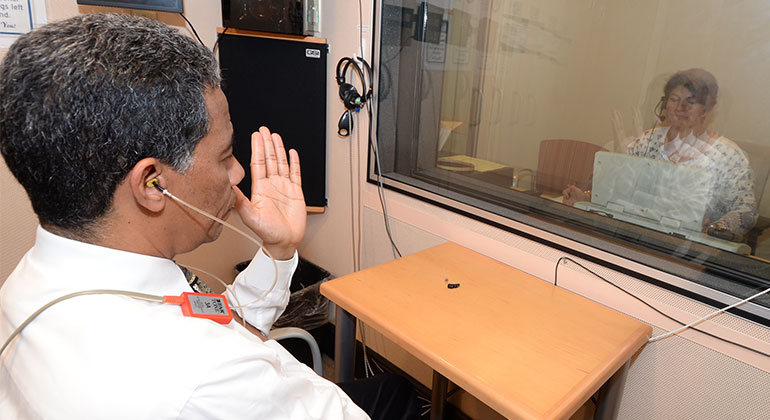
Hearing and Balance Tests
The Ear institute at New York Eye and Ear Infirmary (NYEE), the oldest specialty hospital in America, is a recognized leader in evaluating hearing and balance problems for patients ranging from newborn babies to adults in their nineties. Our professionally licensed and trained audiologists are among the most skilled and experienced anywhere thanks to the volume and variety of cases they routinely handle.
In our comfortable, state-of-the-art facilities in Manhattan, we offer a comprehensive battery of tests for a wide range of hearing and balance disorders. These painless, non-invasive tests—conducted in soundproof rooms—are designed to determine the nature and severity of a potential hearing disorder.
Our audiologists have particular expertise in testing children for hearing loss. Even younger children who won’t respond or cooperate with normal techniques can be tested with special computers (electrophysiologic testing) that give a close approximation of hearing level.
Our Ear Institute auditory specialists are skilled in administering a range of hearing and balance tests, including the following:
Hearing Tests
The following tests help our experts assess a child’s level of hearing:
- Immittance and acoustic reflex testing measures how well the middle and inner ear functions (as opposed to measuring the level of a person’s hearing). During the test, sound is introduced into the ear to see if the muscles in the ear contract.
- Tympanometry detects changes in pressure in the middle ear, as well as fluid behind the eardrum, which can affect a person’s hearing.
- Otoacoustic emissions test helps determine if the tiny hair cells in the inner ear are functioning normally. This test, which can be performed at any age (even infants who are asleep) provides an objective screening for potential hearing loss.
- Pure tone audiometry and speech discrimination testing are the core of the hearing test. Sounds are presented in a range of frequencies and volume to each ear so that the type of hearing loss can be diagnosed. The result of the test is an audiogram diagram, which plots a person's hearing sensitivity at the tested frequencies.
Balance Tests
Symptoms of a vestibular disorder such, as dizziness, vertigo, and imbalance, can impact one’s ability to navigate through one or more activities of daily living, such as bathing, dressing, or simply getting around one’s home. The Ear Institute offers a wide range of vestibular testing, on site. Vestibular testing consists of various tests that can help localize which area of the balance mechanism is causing the problem. Isolating the cause can allow the clinician to treat the patient’s symptom(s).
- Electrocochleography ear test determines if the inner ear (cochlea) has an excessive amount of fluid pressure, which can cause hearing loss, dizziness, or a ringing in the ears (tinnitus).
- Rotary chair is a vestibular testing method often performed with the use of a rotary chair. The patient sits in a chair inside a dark booth. The patient's head is positioned and a camera is placed so that the examiner can watch the patient's eye movements during the test. Once the set-up is completed the chair rotates back and forth, leftward and rightward. This test helps to determine if a balance problem is arising from the ear or the brain. In addition, it can sometimes be used to monitor treatment for dizziness.
- Vestibular nystagmography, or VNG, is a testing series that assesses the vestibular function of the inner ear. This testing involves using infrared goggles to track eye movements during visual stimulation and position changes.
- Vestibular evoked myogenic potential (VEMP) is a test to determine the functionality of the organs of the inner ear. This information may be combined with other vestibular (balance) tests to help pinpoint the cause of vertigo or imbalance.
- Video head impulse test (VHIT) is a test that few hearing centers offer. It detects peripheral vestibular disorders, which are dysfunctions of the balance organs of the inner ear.